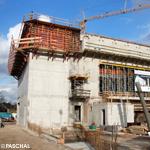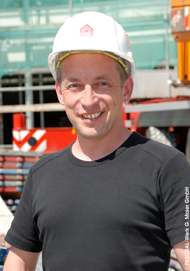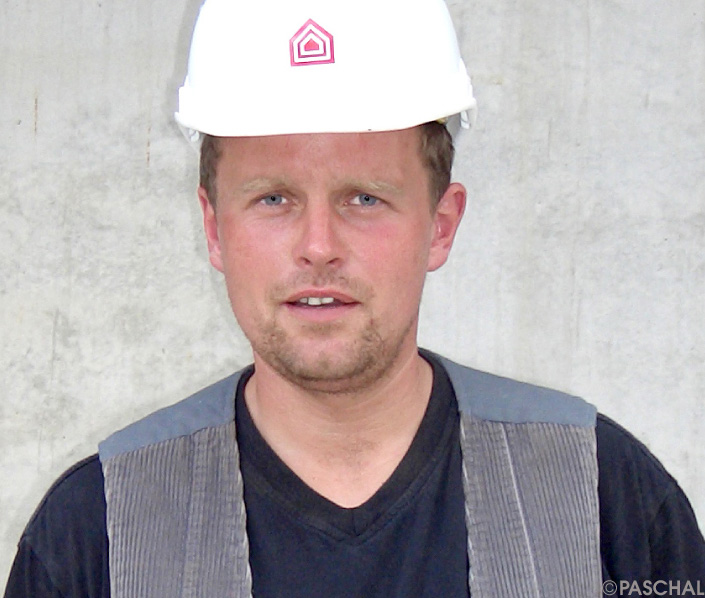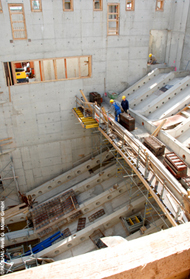One of the most challenging construction sites in Germany: ‘House of Cards’ Architecture in Battle for Materials
New Construction: Guetersloh Theatre
ATHLETE and MODULAR universal formwork from the foundations right up to a height of 26 metresLaws can be a real hindrance - especially if we’re talking about the laws of nature. Architects dream up designs with a complete disregard of these laws, and create structures that fire the imagination, and evoke emotions. It is quite simply, what we refer to as art.
Those, however, who are then tasked to make the architects’ dream a reality, do have to abide by all kinds of laws and regulations - and there are quite a few. If the architect’s dreams are at least moderately restrained, the contractor will have little or no problems to realise them.
If however, the design concepts borders on the impossible, with the laws of physics, material science, and logistics stretched to their limits, and then the men are separated from the boys in the business. And if you add an extra bit of cream on top - well, then you have the most challenging construction site in Germany: The City Theatre in Guetersloh.
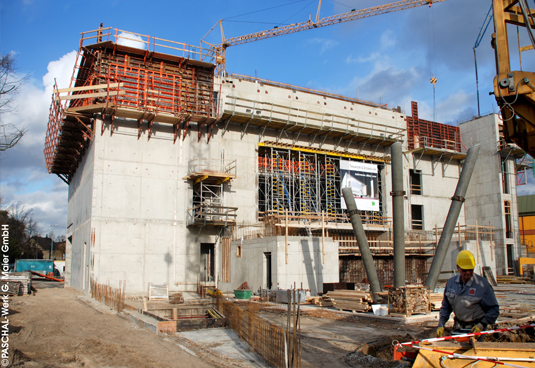
Guetersloh
It all began with a political issue: Should the old, faded theatre simply be renovated - or should it be constructed completely new and from scratch? The city council didn’t take the issue lightly: they discussed, negotiated, and weighed all the pros and cons, before coming to a decision: what could the city of Guetersloh afford, what was needed, and how would the future of the city be affected? A year passed, then another, and then some more. In the end, two local companies with nationwide renown just couldn’t live with indecision anymore, and made the following decision about the old theatre: It just had to go. Considerable sums of money from contributions would be flowing directly into a fund for the new construction.
It worked like a charm! The ice was finally broken, and the planning phase could begin; suddenly, only the best would be good enough.
The client was the Public Works Office (Hochbauamt) in Guetersloh. The projected total for the construction: 23 million euro.
The tender was won by PFP Architekten BDA in Hamburg. The task was nothing if not extraordinary: an auditorium for 480 to 530 people, a stage accessible from all sides, a spectacular lobby, storerooms, rehearsal rooms, everything state-of-the-art and based on the latest know-how. And all this confined to a narrow, predefined inner-city construction site with an area of about 100 to 150 metres.
Their model first looked like a clumsy block that had a box pressed to it on one side and on the back, with the front side somewhat rounded. Given the city’s building regulations as well as the direct vicinity of a protected water tower, the maximum height was limited to 26.5 metres above the upper edge. Still, the building site was already an integral part of the local skyline.
Fechtelkord & Eggersmann GmbH (Marienfled), F&E for short, had the courage to carry out the construction. After the old theater was torn down in 2007, structural work was started in June 2008.
F&E Construction Business Unit Manager, Engineer Ralf Elgner about the project: „Public architecture is an integral part of every culture, and so is a significant foundation of society. In this respect a purely economic view is out of the question!“
Laying the foundations
C 30/37 – 35/45 continuous foundations were set onto the load-bearing subsoil. For example the triple column foundations can take on loads of up to 22 meganewtons per square metre directly beneath the column footing (foundation upper edge). The formwork was waterproof concrete with MODULAR-GE elements from PASCHAL.
Is the project doable?
The building has 1 basement, 1 mezzanine, 1 ground floor, and 5 upper floors on a footprint of 43 x 40 metres. At the centre of it all is the fly tower. The technical parts connect on both sides. The large auditorium is attached to the front of the fly tower. To its side, in turn, the Studio Theatre is attached which stretches out 10 metres beyond the building. In the back the backstage stretches 5 metres out. At about the level of the technical areas the entire front area, i.e. the auditorium and the entire entrance area, is surrounded by a cover of concrete (sides), steel (roof) and glass (front). Construction stage 1 comprises the technical area and fly tower; construction stage 2 comprises the auditorium, construction stage 3 comprises the spiral staircase, the foyer, the main stairway and the studio theatre.
Extreme structural requirements and their solutions
The extreme and super modern static was worked out by Prinz & Pott (Bielefeld). Widely varying component parts of the building demonstrate its peculiarities. Examples:
- The auditorium which appears to levitate is attached to the fly tower. A part of the load in the front has been taken up by two pairs of three angular columns. These are widened as if you were to balance a saucer on three fingers. They have a mere diameter of 45 cm, yet they are made of C 100 /115 spun concrete and can withstand a load of 3700 kN each. The angular bottom is made of concrete components. Above all the 40cm side walls are designed on pressure and keep the auditorium balanced.
Rows of 30-ton prefabricated cross beams carry the 20cm thick auditorium ceiling; they were set using a 300 ton mobile crane. Both sides of the auditorium have massive side walls of 30 cm that are hung onto the above-mentioned cross beams and thus create a tension system. - In particular the side wall adjacent to the water tower stands out, since it also seems to levitate. It is 40 cm thick, 21.8 m high and 29.1 m long. Underneath are only glass, a 4.5 m long concrete wall, small pillars and doors. A 10.5 m section had during construction, despite its height, no side contact and was temporarily braced with steel cables and diagonal HEB 200 steel beams; not until the roof was set and across 43m with only two intermediate supports with HEA 800 steel purlins did the sides bind together. Here as well a major part of the wall load was diverted on tension to the neighbouring parts of the building.
- An in-situ concrete fabricated spiral staircase that widens in top view as you go up connects the upper floors. In the original design, the stairs were to be attached to the particular levels with only minimal connectors. In face of anticipated critical safety- related vertical vibrations with an amplitude of 20 cm it was decided to additionally anchor the stairs to a nearly 22m high concrete column. This spun concrete column with a diameter of 35 cm serves as a fixed spacer and dissipates 4000 kN of load.
- The front of the building is 43m long and 24m high, as big as four tennis courts. It is fully glassed. The panes were not set using conventional methods, since their weight would pass to the base. Rather, they were hung in a row on the uppermost located steel cross beam.
F&E Construction Business Unit Manager, Engineer Ralf Elgner: „This is architecture! In this special and unparalleled building the forces were taken for a walk with modern static calculations!“
Concrete and Form Works
Fechtelkord & Eggersmann GmbH has its own Formwork park equipped with PASCHAL ATHLETE system elements as well as MODULAR Universal formwork equipment. In addition, material for the construction site was rented from the neighbouring PASCHAL Gifhorn branch. Stefan Kisse, foreman of reinforced concrete and masonry teams: consultations by PASCHAL consultant Getz were excellent, and the prepared formwork drawings always good.“
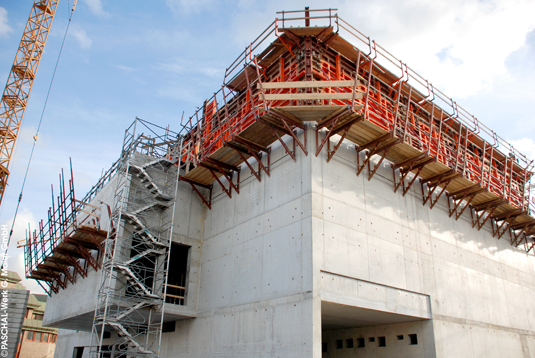
Small complicated areas were done with MODULAR, whereas ATHLETE was used for foundations and walls and fulfilled a major part of the formwork jobs at this construction site. With that, the ATHLETE was used not only as for traditional wall formwork, but also as climbing up to a height of 23m, while maintaining a climbing height cycle of 4.20 m. The climbing turned out to be demanding due to reinforcement issues, that a 23m high self standing wall has given the laws of physics. All workers on the platform had to strap themselves for safety reasons!
The ATHLETE Large-Size Formwork is a steel frame formwork which is ideally suited for use in industrial and civil engineering. It offers record values in regards to fresh concrete pressure and tolerances of deflection, as well as low numbers of ties within the concrete. The sophisticated formwork system also opens up a variety of applications for structural and underground construction. Hollow box sections constructed from high-strength steel with a construction height of 16cm, and trapezoid or omega-shaped profiles, their relevant material thickness and constructive optimisation allow for highest fresh concrete pressure.
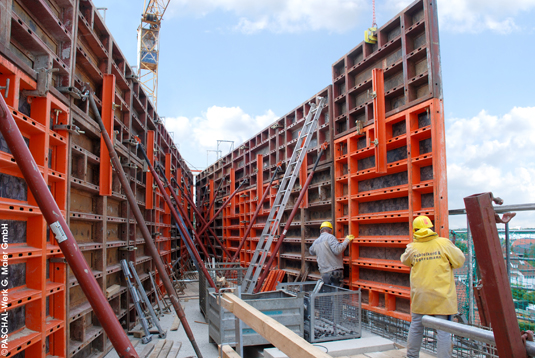
In summary, there were 32,000 square metres of surface to be formed.
Supports were also used. Particularly the 20m high heavy load support of a joist inside the building is a case worth mentioning.
The spiral-shaped staircase was produced traditionally using the carpenter’s method, since each square metre was different and lacked repeatable elements. All other stairs are prefabricated parts ex works.
The reinforcement had to be especially strong because of static reasons. Not only more iron was interwoven than usual, it also had a diameter of up to 28 mm. As tribute to the highly complex static, the reinforcements of the individual building elements were clamped together using bolted connections. For a few critical transition points even special welders from other Federal States had to be employed.
In total, 7.500 m³ of C30/37, C35/45 and C40/50 concrete was used, as well as 740 tons of steel.
The House of Cards: Planning and Logistics a Material Battle
The limited-space inner city site did not allow for any significant stock holding. Three cranes were relentlessly busy. No winter breaks were made.
Material delivery was carried out just-in-time. With the considerable volumes involved, complex planning was necessary, connected with extensive experience on how the crews could carry out as calculated. Though construction is divided into several construction stages, many work processes run in parallel. Furthermore the complex static with component parts attached to ceilings or upper floors forces a huge material battle on the contractor. This is because all support measures for the floors/ceilings or beams underneath, as complex as they may be, cannot be removed as long as the structures that bear the loads above and stabilize the construction are not completed. If the support were to be removed, the nearly finished construction would collapse like a house of cards. Cycling, or the gradual, repetitive, and therefore efficient reuse of building materials was thus impossible throughout construction.
Up until the ceiling was constructed, a major part of the supports had to remain under the auditorium. This particularly applied to the apparently free floating side walls: the steel columns integrated during construction stayed there right up to the end. Only after the structural work phase was over, when nothing more could be changed or improved, could they be removed.
F&E Site Manager Engineer Ralf Hündorf is quite happy with the successful course to date, but emphasizes the high expectations: „This is no simple multi-storey house! - This is a once in a lifetime construction site – after that you’ve simply seen it all!“
Outlook
Spring of 2010 should see the inauguration of the building. A troupe of actors, management and performance programs are already in place. The main service area of the theatre is the District of Guetersloh and the neighbouring communities.
Construction Blackboard
Contracting Entity: Public Works Office of the City of Guetersloh
Construction Contractor: Fechtelkord & Eggersmann GmbH, Marienfeld
Architects: PFP Architekten BDA, Hamburg
Project Management, External Construction Supervision: Oehme & Partner GbR, Bielefeld
Statics, Consulting Engineers: Prinz & Pott, Bielefeld
Foundation, Wall, and Climbing Formwork: PASCHAL-Werk G. Maier GmbH




